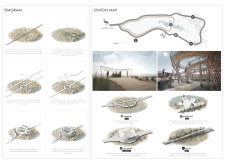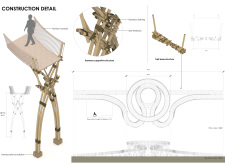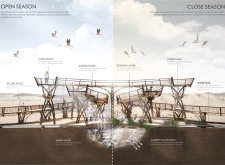5 key facts about this project
Cumulative Phenomenon, situated within the unique ecological context of Al Wathba, showcases a design that emphasizes interaction and education. The structure has two primary functions: during the open season, it serves as an observatory, allowing visitors to engage with the wetlands, while in the closed season, it transforms into a monument that focuses on environmental regeneration. The overall concept encourages a close relationship between people and nature.
Functionality and Seasonal Adaptability
The design adapts to seasonal variations effectively. In spring and summer, the structure invites people in to explore and learn about the local ecosystem, promoting awareness of the region’s biodiversity. Once the closed season begins, the emphasis shifts from visitor engagement to allowing the environment to recover, showcasing the importance of adaptive design that respects natural cycles.
Pathways and Interaction with Ecosystem
Visitors follow an intricate network of pathways that guide them through different landscape experiences. These paths vary in incline and shape, enhancing the overall journey while ensuring accessibility for all. The trails lead to essential features like a botanical pond, which acts as both an educational tool and an area of visual interest. Elevated viewpoints throughout the design offer unobtrusive vantage points for observing wildlife, helping people connect with the surroundings without disturbing them.
Material Choices and Structural Elements
The foundation is made using hempcrete, a material recognized for its sustainability and lightness, which provides structural stability. Handrails crafted from rattan contribute to a natural feel, blending well with the environment. The main support structure is built from bamboo, chosen for its strength and rapid growth. This careful selection of materials highlights the commitment to environmentally friendly practices and local resource utilization throughout the design.
Biodiversity and Environmental Integration
The design places a strong emphasis on supporting local biodiversity. Gaps within the structure are intentional, allowing birds and other creatures to nest, thus enhancing the ecological habitat. The central botanical pond offers a space for observing the interactions between different species and plant life. Additionally, the microclimate created by the water vapor rising from the pond contributes to improved comfort and promotes the growth of various plants.
The experience is further enriched by shaded areas that blend into the landscape, providing relief from the sun while respecting the environment. Each aspect of the design demonstrates an understanding of how architecture can enhance connections with the natural world and serve the community's educational needs effectively.





















































